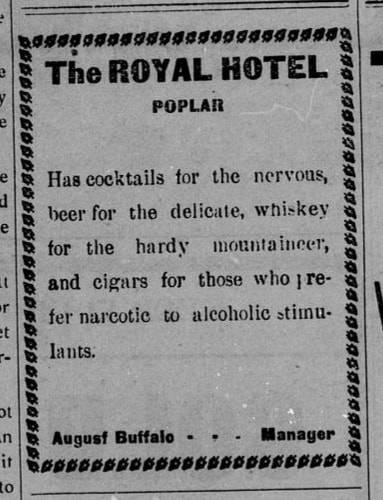A series on West Kootenay/Boundary place names
By Greg Nesteroff
Special to Black Press
Having spent almost five years going through the alphabet, we’ll now back up and make a second pass, this time covering some places omitted the first time round either because they were too small, too obscure, or we just plain overlooked them. We’ll also provide new details on some places we’ve already touched on.
BOOMER’S LANDING
This spot at Blueberry Creek was the construction headquarters for the Columbia and Western Railway between Trail and Robson.
It was first mentioned in the Trail Creek News of Jan. 8, 1897: “Three camps have been established and work is now well under way on the Trail-Robson road. One camp is located at Rock Creek, three miles up the road, and another about a mile this side of Waterloo, which the men have named Boomer’s Landing in honor of H.H. Boomer, one of the contractors.”
Elsewhere in the same issue, Boomer was described as “a pioneer of Boomers landing and the leading citizen of that place.”
Herbert Harry Boomer (1858-1947) was born in Nova Scotia and immigrated to the US in 1889. He did work for the Great Northern, Northern Pacific, and Canadian Pacific railways, among others. He was a a partner in the Butte, Montana contracting firm of Winters, Parsons, and Boomer.
The 1897 BC directory listed Boomers’ Landing as a “steamboat landing 15 miles from Trail and 10 mile from Robson. Headquarters for the Robson & Trail Railway.” Winters, Boomer, and Parsons were listed as railway contractors and general store proprietors while John Pirith was listed as their bookkeeper.
Once the railway was completed, Boomer’s Landing faded away. The last known reference was in a pamphlet published in April 1898 called Kootenay Guide that listed Boomers as a steamer landing between Robson and Montgomery.
The Anaconda (Montana) Standard of Jan. 16, 1901 reported “H.H. Boomer, the well known railroad contractor and capitalist,” had been arrested in Boston, mistaken for a kidnapper. He laughed it off. He later moved to San Francisco but died in Spokane at the Davenport Hotel.
BRADYSBURG
The only evidence this place existed are two references in the Silvertonian.
From Dec. 17, 1898: “Bradysburg at the foot of the Wakefield trail is at times quite a busy place, when the rawhides strike it with their string of mules. Here the voice of the long-eared Rocky Mountain canary can be heard, at almost any hour of the night, singing a lullaby to the tired inhabitants.”
And from Oct. 4, 1899: “Bradysburg at the foot of the Wakefield tramway is one of the busiest places in the whole Slocan. It is here that the Wakefield concentrator is being erected and is the headquarters for the contractors building the flume and tramway …”
A number of men named Brady were in the area at the time, but we’ll guess the namesake was Hugh Brady (1873-fl. 1921), who hauled ore from the Wakefield before the tram was built.
Brady was in the Slocan by 1894, when he staked one of many mining claims. In 1899, he received a letter from his partner James Anderson at Atlin, encouraging him to sell out and head north. Brady did so, but returned at year’s end. In 1903, Brady joined a mining rush to White River, in the Yukon and nearly got killed. “What is worse,” The Ledge reported on Sept. 19, 1904, “he lost his stock and $6,000. He is, however, now rich enough to be in the hospital with a broken leg.”
Brady was still in the Yukon as of 1921.
BUFFALO LANDING
A single reference exists to this place, in the Kaslo Kootenaian of June 29, 1899: “The landing at the head of Duncan river has been named Buffalo landing.”
The name didn’t come from the animal but probably from August Buffalo, who staked the Buffalo mines at Poplar Creek and ran the Royal Hotel there, which promised “cocktails for the nervous, beer for the delicate, whiskey for the hardy mountaineer, and cigars for those who prefer narcotic to alcoholic stimulants.”
The Poplar Nugget of Dec. 4, 1903 reported: “On Cascade Creek, about two miles from Poplar, August Buffalo has had the Dominion and Dick claims for six years … [He] staked part of the Lucky Jack ground more than a year ago and called it the Royal claim. He did one assessment, gave his partner the money to record the work, but he skipped and Buffalo lost the claim.”
According to the Nelson Daily Canadian of Sept. 17, 1906, “The Buffalo mines were bonded in 1904 by Finch and Campbell; a tunnel was driven 50 feet and crosscuts with a total length of between 400 and 500 feet … Then came lawsuits, the curse of mining in Kootenay and the special bane of Poplar district. Finch and Campbell threw up the property in disgust and it has remained idle ever since.”
W.B. Pool was reported to have taken over the property with plans to put in a stamp mill, but it didn’t amount to much.
Buffalo was still prospecting in the Lardeau as of 1907, but died in Nelson in 1912 of chronic bronchitis.

